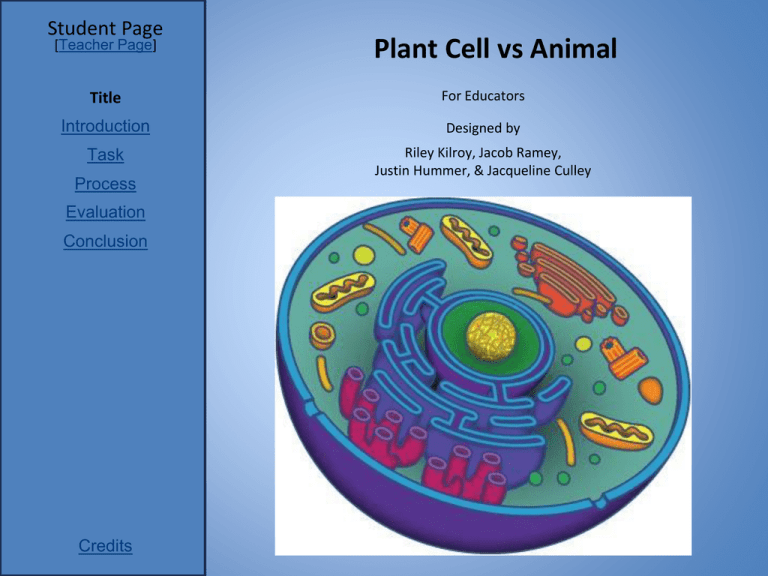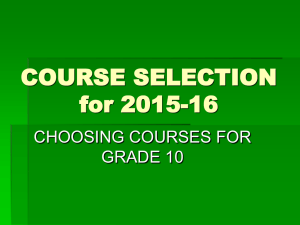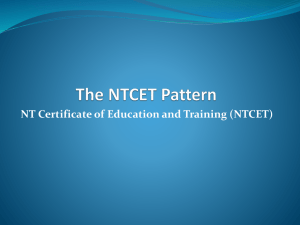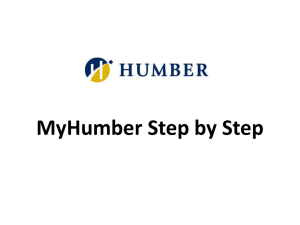Teacher Page - Riley Kilroy`s e
advertisement

Student Page [Teacher Page] Plant Cell vs Animal Title For Educators Introduction Designed by Task Riley Kilroy, Jacob Ramey, Justin Hummer, & Jacqueline Culley Process Evaluation Conclusion Credits Based on a template from The WebQuest Page Student Page Introduction [Teacher Page] Title Introduction Task Process Evaluation Conclusion Credits Jacob Today you will be learning about cells, the building blocks of life. Everything living is made up of cells. So, today you will be specifically researching and learning about specific things that involve animal cells and plant cells (a cell is the smallest structural and functional unit of an organism). These two cells will have some similarities but they will also have some differences as well. Once you go through each slide you should be able to easily distinguish between the two. Student Page [Teacher Page] Title Introduction Task Task So here’s the deal: This webquest will teach you all you need to know about the cell - you know...those miniscule pieces that make up your body, your pet, plants, and any other living thing on this planet. Process Evaluation Conclusion Credits By the time you have read the conclusion, you should be familiar with the structure of plant versus animal cells, photosynthesis and cell division. Make sure you’re ready to learn. Do some jumping jacks, stand on your head, and get a snack. Ready, set, go... http://1.bp.blogspot.com/-PIyRXOf_TqM/Tb3Lo6dzAAI/AAAAAAAADbU/S_sm2gCWgj4/s1600/Animal+vs+Plant+Cell.JPG Jacqueline Student Page The Plant Cell [Teacher Page] Title First, break off into groups of 2. Each group can share one computer to work through the webquest. Introduction Task Process Evaluation Conclusion The plant cell is significantly different from the animal cell. What are the differences? What are the different functions that each part of the plant cell posses? Click the link and first start the tutorials of each to see the differences and then play the game to test your knowledge of the plant cell. http:t//www.sheppardsoftware.com/health/anatomy/cell/index.htm To further understand the different parts of the plant cell and their functions click the link below and then click on plant cell. Click on the different parts of the cell to pull up the details for that part. http://www.cellsalive.com/cells/cell_model.htm After you feel like you have obtained a solid understanding of the plant cell model you can print off two copies of the worksheet found on the link below. Each team member should have their own copy of the worksheet to individually turn in. Color the parts of the cell according to the color next to the name and then answer the four questions below. http://www.biologycorner.com/worksheets/cell_color_plant.html#.UlVluhBld 3s Credits Justin Student Page Animal Cell Structure [Teacher Page] Title Introduction Task Process Evaluation Conclusion What are the parts of the animal cell? What exactly do these parts do? Click the link below and go find out! http://www.enchantedlearning.com/subjects/animals/cell/ To get more in depth information about each particular piece of an animal cell click the link below. http://www.wisc-online.com/Objects/ViewObject.aspx?ID=AP11403 After you go through these links and feel confident that you know what each part is, where it is, and what it does take this quiz. ://www.sciencegeek.net/Biology/rehttpview/U1animalcells.htm Once you have finished all these activities, in your group build a model of an animal cell.It doesn’t matter how you make it, it just has to be 3D. For example you can use different types of candy’s and make the model that way. Credits Jacob Student Page Photosynthesis [Teacher Page] What??? Title Introduction Task Process Evaluation Conclusion “photo” - from Greek “phôs” - “light” + “synthesis” - from Greek “sýnthesis” - “put/place with” ● http://www.neok12.com/php/watch.php?v=zX425c515e426609045 00606&t=Photosynthesis Okay, what does it do? ● http://www.chemicalformula.org/photosynthesis Wait what? ● http://www.neok12.com/php/watch.php?v=zX4b7a504d047d5b6e6 60173&t=Photosynthesis ● http://www.biology4kids.com/files/plants_photosynthesis.html Tell me more! ● http://www2.estrellamountain.edu/faculty/farabee/biobk/BioBookP S.html Now...find the source of the room’s artificial sun. Underneath is a box of tissue paper, cupcakes, construction paper, pipe cleaners, various candy, flowers and markers. Your job is to show me what the these websites are saying. Your diagram should be comprehensible by a first grader. Credits Jacqueline Cell Division Student Page [Teacher Page] Title Begin by reading through this overview of cell mitosis. http://www.biology.arizona.edu/cell_bio/tutorials/cell_cycle/cells3 .html Introduction Task Process Follow the animation to gain a better understanding. http://www.wisconline.com/Objects/ViewObject.aspx?ID=BIO204 Evaluation Conclusion Watch a few videos until you have mastered it. http://www.neok12.com/Cell-Division.htm Still want more? Follow through with more detailed information. http://www.uic.edu/classes/bios/bios100/lecturesf04am/lect16.ht m After you have grasped the material create a visual comparison of mitosis vs. meiosis. The world is your canvas, it can be visual, digital, or tactile, just find ways to incorporate information into your representation. Credits Riley Student Page Evaluation [Teacher Page] Title Introduction Task Student failed to complete the assignment. (0) Process Evaluation Conclusion The Plant Cell Animal Cell Structure Cell Division Photosynthesis Credits Riley Student completed assignment with lack of understanding of material. (1) Student completed assignment showing a general understanding of material. (2) Student completed assignment showing a deep understanding of material. (3) Student Page Conclusion [Teacher Page] Title Introduction Task Cells are the smallest functional units of living things. Cells Make energy, proteins and other essential substances for organisms to survive. Cells help plants and animals to move, grow, reproduce, and digest the food they eat. Without them working properly and every part of the cell working together as a team nothing would be able to function properly. After completing this webquest you are now one step closer to understanding living organisms and how the cells keep everything alive. Pretty cool huh!? Process Evaluation So what about us? What about the Human Cell? How do we function in the ways that we do? How are our cells different from plant and animal cells? Conclusion Here a couple sites to get you started: http://people.eku.edu/ritchisong/301notes1.htm#organelles http://www.livescience.com/14827-human-cell-nucleus-endoplasmic-reticulummitochondria.html Credits Justin Student Page [Teacher Page] Title Introduction Task Process Credits & References Cover Picture: "Stem Cells 101." Stem Cells, Inc. National Institute of Health, n.d. Web. 15 Oct. 2013. <http://www.stemcellsinc.com/science/stem-cells-101.htm>. Introduction Picture: Poblocki, Alicia. "Animals and Habitats." Canisius.edu/~grandem. Canisius College, n.d. Web. 15 Oct. 2013. <http://www3.canisius.edu/~grandem/animalshabitats/JungleAnimalsBorder.jpg>. Task Picture "Animal vs. Plant Cell." N.p., n.d. Web. 15 Oct. 2013. <http://1.bp.blogspot.com/PIyRXOf_TqM/Tb3Lo6dzAAI/AAAAAAAADbU/S_sm2gCWgj4/s1600/Animal+vs+Plant+Cell.JPG>. Evaluation Conclusion The Plant Cell: "Cell Menu." Cell Menu. N.p., n.d. Web. 16 Oct. 2013. <http://www.sheppardsoftware.com/health/anatomy/cell/index.htm>. "Eucaryotic Cell Interactive Animation." Cell Models: An Interactive Animation. N.p., n.d. Web. 16 Oct. 2013. <http://www.cellsalive.com/cells/cell_model.htm>. "Plant Cell Coloring." Plant Cell Coloring. N.p., n.d. Web. 16 Oct. 2013. <http://www.biologycorner.com/worksheets/cell_color_plant.html>. Animal Cell Structure: "Animal Cell Anatomy." Animal Cell Anatomy - EnchantedLearning.com. N.p., n.d. Web. 15 Oct. 2013. <http://www.enchantedlearning.com/subjects/animals/cell/>. Heins, Gerald. "Learning Objects Help People Succeed." A Typical Animal Cell. Wisc-online, n.d. Web. 15 Oct. 2013. <http://www.wisc-online.com/Objects/ViewObject.aspx?ID=AP11403>. "Animal Cell Strucure." Science Geek. N.p., n.d. Web. 15 Oct. 2013. <http://www.sciencegeek.net/Biology/review/U1animalcells.htm>. Photosynthesis: "Discovery of Photosynthesis." Discovery Youtube Education. Discovery, n.d. Web. 15 Oct. 2013. <http://www.neok12.com/php/watch.php?v=zX425c515e42660904500606&t=Photosynthesis>. "Chemical Formula." Chemical Formula for Photosynthesis. N.p., n.d. Web. 16 Oct. 2013. <http://www.chemicalformula.org/photosynthesis>. "Plants: Photosynthesis." Britannica.com, n.d. Web. 16 Oct. 2013. <http://www.neok12.com/php/watch.php?v=zX4b7a504d047d5b6e660173&t=Photosynthesis>. "PHOTOSYNTHESIS -PART I: THE SUN AND LIGHT." Biology4Kids.com: Plants: Photosynthesis. N.p., n.d. Web. 16 Oct. 2013 <http://www.biology4kids.com/files/plants_photosynthesis.html>. Farabee. "PHOTOSYNTHESIS." PHOTOSYNTHESIS. N.p., n.d. Web. 16 Oct. 2013. <http://www2.estrellamountain.edu/faculty/farabee/biobk/BioBookPS.html>. Credits Student Page [Teacher Page] Title Introduction Task Process Evaluation Conclusion Credits Credits & References Cell Division: "The Cell Cycle & Mitosis Tutorial." The Cell Cycle & Mitosis Tutorial. N.p., n.d. Web. 16 Oct. 2013. <http://www.biology.arizona.edu/cell_bio/tutorials/cell_cycle/cells3.html>. "Learning Objects Help People Succeed." Cell Division. Wisc.com, n.d. Web. 16 Oct. 2013. <http://www.wisconline.com/Objects/ViewObject.aspx?ID=BIO204>. "Educational Videos, Lessons and Games for K-12 School Kids." Cell Division. N.p., n.d. Web. 16 Oct. 2013. <http://www.neok12.com/Cell-Division.htm>. "Cell Division, Mitosis, and Meiosis." Cell Division. Universiy of Illinios at Chicago, n.d. Web. 16 Oct. 2013. <http://www.uic.edu/classes/bios/bios100/lecturesf04am/lect16.htm>. Conclusion: Song, R. (2008). Cell structure & function. n.d. Web 16 Oct. 2013 <http://people.eku.edu/ritchisong/301notes1.htm Machalek , A. (2011). The amazing world inside a human cell. n.d. Web. 16 Oct. 2013. <http://www.livescience.com/14827-human-cell-nucleus-endoplasmic-reticulum-mitochondria.html [Student Page] Teacher Page Put the Title of the Lesson Here (Teacher) Title A WebQuest for xth Grade (Put Subject Here) Introduction Designed by Learners Put Your Name Here Put Your E-mail Address Here Standards Process Resources Evaluation Teacher Script Conclusion Credits Based on a template from The WebQuest Page [Student Page] Teacher Page Title Introduction Learners Standards Process Resources Evaluation Teacher Script Conclusion Credits Introduction (Teacher) Begin with something that describes the origin of the lesson. For example: This lesson was developed as part of the San Diego Unified School District's Triton Project, a federally funded Technology Innovation Challenge Grant. In this second paragraph of the introduction, describe briefly what the lesson is about. Remember, the audience for this document is other teachers, not students. [Student Page] Teacher Page Title Introduction Learners (Teacher) Describe the grade level and course that the lesson is designed to cover. For example: "This lesson is anchored in seventh grade language arts and involves social studies and math to a lesser extent." If the lesson can easily be extended to additional grades and subjects, mention that briefly here as well. Learners Standards Process Resources Evaluation Teacher Script Conclusion Credits Describe what the learners will need to know prior to beginning this lesson. Limit this description to the most critical skills that could not be picked up on the fly as the lesson is given. [Student Page] Teacher Page Title Introduction Curriculum Standards (Teacher) What will students learn as a result of this lesson? Describe the outcomes succinctly. Use the language of existing standards. For example: Social Studies Standards Addressed Learners Standards Process Resources Evaluation Teacher Script Conclusion Credits •Recognize the relationships among the various parts of a nation's cultural life. •Learn about the mythology, legends, values and beliefs of a people . Most lessons don't just teach a block of content; they also implicitly teach one or more types of thinking. In addition to describing learning outcomes within traditional subject areas, describe what kind of thinking and communications skills were encouraged by this lesson. Inference-making? Critical thinking? Creative production? Creative problem-solving? Observation and categorization? Comparison? Teamwork? Compromise? [Student Page] Teacher Page Title Introduction Learners Standards Process Resources Evaluation Teacher Script Conclusion The Process (Teacher) You can paste in the process description given to students in the “You can paste in the process description given to students in the “studentYou can paste in the process description given to students in the “student”You can paste in the process description given to students in the “student” process slide and then interleave the additional details that a teacher might need. Describe briefly how the lesson is organized. Does it involve more than one class? Is it all taught in one period per day, or is it part of several periods? How many days or weeks will it take? Is it single disciplinary, interdisciplinary, multidisciplinary or what? If students are divided into groups, provide guidelines on how you might do that. If there are misconceptions or stumbling blocks that you anticipate, describe them here and suggest ways to get around them. What skills does a teacher need in order to pull this lesson off? Is it easy enough for a novice teacher? Does it require some experience with directing debates or role plays, for example? If you're designing for a one-computer classroom or for pre-readers and are creating a facilitated WebQuest in which the teacher or an aide controls the computer and guides discussion, you can link from here to the Teacher Script page which would contain a printable script for the facilitator to follow. Variations If you can think of ways to vary the way the lesson might be carried out in different situations (lab vs. in-class, for example), describe them here. Credits [Student Page] Teacher Page Title Introduction Learners Standards Process Resources Evaluation Teacher Script Conclusion Credits Resources (Teacher) Describe what's needed to implement this lesson. Some of the possibilities: •Class sets of books •E-mail accounts for all students •Specific software (how many copies?) •Specific hardware (what kind? How many?) •Specific reference material in the classroom or school library •Video or audio materials If the lesson makes extensive use of specific websites, it would be appropriate to list, describe and link them here. Describe also the human resources needed. how many teachers are needed to implement the lesson. Is one enough? Is there a role for aides or parents in the room? Do you need to coordinate with a teacher at another school? With a partner in industry or a museum or other entity? Is a field trip designed in as part of the lesson? [Student Page] Teacher Page Title Introduction Learners Standards Process Resources Evaluation Teacher Script Conclusion Credits Evaluation (Teacher) How will you know that this lesson was successful? Describe what student products or performances you'll be looking at and how they'll be evaluated. This, of course, should be tightly related to the standards and objectives you cited above. You may want to just copy and paste the evaluation section of the student page (Evaluation) into this space and add any clarifications needed for another teacher to make use of this lesson. [Student Page] Teacher Page Title Introduction Learners Standards Process Resources Evaluation Teacher Script Conclusion Teacher Script (Teacher) The WebQuest model is best suited for learners who can navigate the Web on their own and can read the kinds of material commonly found on the Web. We can stretch the format to reach primary-aged learners, developmental English Language Learners and special populations by creating a facilitated WebQuest, one that requires an adult or older peer to drive things. Use this page to create a script for that facilitator. The facilitator would print this page out and use it to guide their progress through the WebQuest. This page will include step by step directions to the facilitator, including: •What to say at each point in the process •What to click on •What questions and misconceptions to anticipate •How long to take at each point •When to direct learners to work away from the computer To help the facilitator, you might want to include screen dumps of particular screens embedded with the directions of what to do at that point. This page is linked to the Process segment off of the Teacher Page Credits [Student Page] Teacher Page Title Introduction Learners Standards Process Resources Evaluation Teacher Script Conclusion Credits Conclusion (Teacher) Make some kind of summary statement here about the worthiness of this lesson and the importance of what it will teach. [Student Page] Teacher Page Title Introduction Credits & References (Teacher) List here the sources of any images, music or text that you're using. Provide links back to the original source. Say thanks to anyone who provided resources or help. List any books and other analog media that you used as information sources as well. Learners Standards Process Resources Evaluation Teacher Script Conclusion Credits Include a link back to The WebQuest Page Include a link back to The WebQuest Page and The WebQuest Slideshare Group so that others can acquire the latest version of this template and training materials.








